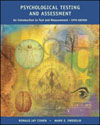 |  Psychological Testing and Assessment: An Introduction To Tests and Measurement, 5/e Ronald Jay Cohen
Mark Swerdlik
Neuropsychological Assessment
| Aphasia | A loss of ability to express oneself or to understand spoken or written language due to a neurological deficit, 461
|  |  |  | | Bender-Gestalt test | A widely used screening tool for neuropsychological deficit that entails copying designs; also referred to simply as "the Bender;" developed by Lauretta Bender, M.D., 450n, 467-469, 470, 495
|  |  |  | | Confrontation naming | Identifying a pictured stimulus in a neuropsychological context, such as in response to administration of items in the Boston Naming Test, 458, 459, 460 Connors Rating Scales-Revised (CRS-R), 289
|  |  |  | | Contralateral control | Phenomenon resulting from the fact that each of the two cerebral hemispheres receives sensory information from the opposite side of the body and also controls motor responses on the opposite side of the body; understanding of this phenomenon is necessary in understanding brain-behavior relationships and in diagnosing neuropsychological deficits, 446
|  |  |  | | Declarative memory | Memory of factual material; contrast with procedural memory, 463-464
|  |  |  | | Deterioration quotient (DQ) | Also referred to as a deterioration index, this is a pattern of subtest scores on a Wechsler test that Wechsler himself viewed as suggestive of neurological deficit, 460
|  |  |  | | Executive functions | In neuropsychology, organizing, planning, cognitive flexibility, inhibition of impulses, and other activities associated with the frontal and prefrontal lobes of the brain, 457
|  |  |  | | Fixed battery | A prepackaged test battery containing a number of standardized tests to be administered in a prescribed fashion, such as the Halstead-Reitan Neuropsychological Battery; contrast with flexible battery, 473, 474, 475-476
|  |  |  | | Flexible battery | Best associated with neuropsychological assessment, a group of tests hand-picked by the assessor to provide an answer to the referral question; contrast with fixed battery, 470, 473, 474
|  |  |  | | Neurological damage | Impairment, injury, harm, or loss of function of any part or process of the central or peripheral nervous systems, 447-449
|  |  |  | | Neurology | A branch of medicine that focuses on the nervous system and its disorders; contrast with neuropsychology, 445
|  |  |  | | Noninvasive procedures | A method of evaluation or treatment that does not involve intrusion (by surgical procedure, X-ray, or other means) into the body; for example, in a neuropsychological evaluation, observation of the client walking or skipping, 453
|  |  |  | | Organicity | An abbreviated reference to organic brain damage and to one of the varieties of functional consequences that attends such damage, 447-449
|  |  |  | | Pattern analysis | Study of the pattern of test scores on a Wechsler or other test in order to identify a pattern associated with a diagnosis (such as neurological deficit in the right hemisphere), 460
|  |  |  | | Procedural memory | Memory for how to do certain things or perform certain functions; contrast with declarative memory, 463
|  |  |  | | Trail making item | An item that taps visual-conceptual, visual-motor, planning, and other cognitive abilities by means of a task in which the testtaker must connect the circles in a logical fashion; the component of the Halstead-Reitan Neuropsychological Battery called the Trail Making Test is one of the most widely used instruments for the assessment of brain damage, 457-458
|
|



 2002 McGraw-Hill Higher Education
2002 McGraw-Hill Higher Education